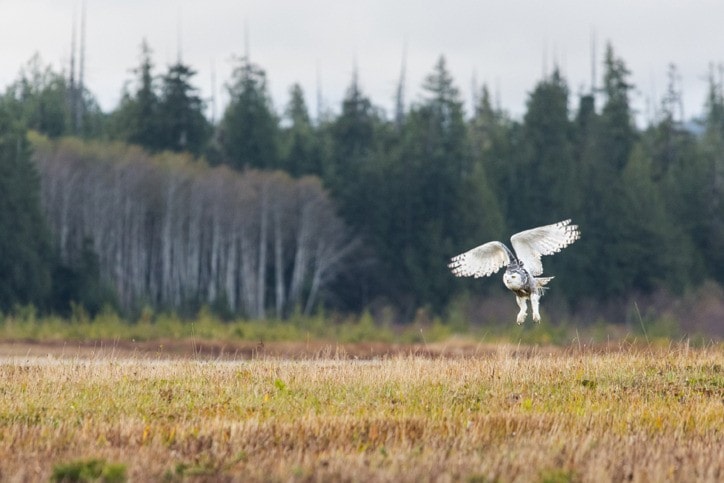A recent flurry of sightings of snowy owls on the North Island has provided some excitement for bird-watchers and nature-lovers unaccustomed to seeing raptors not native to the area. It is a rather less positive development for the birds, however.
"People see a beautiful, snowy-white owl," said Maj Birch, founder and director of the Mountainaire Avian Rescue Society in the Comox Valley. "But underneath they're just skin and bones. They've lost their flight muscles."
The snowy owl, normally a resident of the tundra of Northern Canada and Alaska, was first reported locally a few weeks ago, when some residents reported white owls dive-bombing their cars in areas near Seven Mile Landfill and Beaver Cove Road near Port Hardy.
Since the first sightings, two owls in weakened, emaciated states have been rescued and sent on to MARS. The first, collected by Tim Marion and Lindy Kelman and Elaine Stewart at Cluxewe Resort Nov. 9, has died, said Birch. The second, which was originally brought to Port Hardy Veterinary Hospital Nov. 13, is still hanging on but is in an extremely weakened condition.
"It's a real challenge to try to bring these guys back from the brink," said Birch. "The last thing anybody would want to do is try to feed them if they do capture them. The energy they expend trying to digest solid food would cost them more than they'd gain."
MARS staff this week was tube-feeding the surviving bird a solution that included vitamins and amino acids, and an anti-parisitic was being prepared to help the owl fight off any parasites that might be impacting its recovery.
The snowy owl, the official bird of Quebec, is the largest owl in North America on average, standing roughly two feet tall and with a wingspan of four-to-five feet. Males are typically almost all white, while females and juveniles have dark gray tips on their wing, tail and head feathers. They are also distinctive for their yellow eyes.
Birch said the two owls sent to the rescue centre from the North Island are among four snowy owls the centre has received this month from areas across the Island. Only one has survived to date.
She believed the birds may be the result of a natural jump in the population of prey animals on the northern tundra this spring, which likely resulted in large broods of snowy owls being born in the birds' traditional nesting areas in the north.
Once the young birds are ready to fledge, or "leave the nest", however, they find themselves in an overpopulation situation, relative to the available habitat and forage, and fly off in an irruption to find other hunting areas. Unfortunately, the very birds who migrate to southern regions like Vancouver Island are the least-experienced hunters and arrive in heavily forested areas which bear little similarity to the wide-open tundra for which they are best suited.
"Usually, they're starving by the time they get here," said Birch.
The first North Island rescue bird was spotted by Marion when he went to Cluxewe Resort to pick up his wife, Kelman, from work at the restaurant there.
"I noticed the owl standing close to the firewood storage area at Cluxewe, and realized right away this was not just any owl," said Marion. "I saw two large house cats stalking up on it real close, and I took out my (phone) camera and took a couple of pictures, thinking it was going to fly right off. But the owl hopped a couple of times, flew once 20 or 30 feet real close to the ground, then sort of belly-flopped.
"That's when I really started to think something was wrong with the bird."
Marion called the Conservation Officer Service, which promptly put him in touch with MARS. The centre suggested using thick leather gloves and a blanket to grab the bird, and "to do your best to capture it and avoid being bit," said Marion.
With Kelman recording on a cell phone, Stewart rounded up the gloves and blanket and Marion and Stewart collected the reluctant but mostly non-combative bird.
"It was an interesting experience," he said.
MARS put out a notice on social media to find somebody in the area to return the owl to the Comox Valley and learned CTV reporter Gord Kurbis was in the area to do a story on Willie Mitchell's visit to Chilton Arena to donate hockey helmets to the local hockey association. Kurbis delivered the bird, then later did a story for broadcast on the second bird sent down from Port Hardy.
Birds rehabilitated at Mars are typically reintroduced into the wild within 10 kilometres of the spot at which they were located. That was the case with two eagles and a juvenile blue heron rescued and later released on the North Island earlier this year.
But the owls, who are well outside their normal hunting range, are an exception.
"I think these owls have been spotted occasionally here," said Dr. Valerie Drolet, a veterinarian at the Port Hardy Animal Hospital. "Usually they're spotted this time of year around the airport, but not as many as this year. We're really, really lucky. I think people here are extraordinary; there's a community spirit here to help wildlife."
